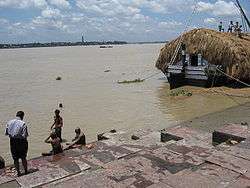Bagbazar
| Bagbazar | |
|---|---|
| Neighbourhood in Kolkata (Calcutta) | |
|
Bagbazar Ghat on Hooghly River | |
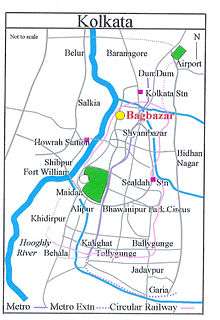 | |
| Country |
|
| State | West Bengal |
| City | Kolkata |
| Ward |
|
| Metro Station | Shyambazar |
| Parliamentary constituency | Kolkata Uttar |
| Assembly constituency | Shyampukur |
| Elevation | 36 ft (11 m) |
| Population (2001) | |
| • Total | 20,012 |
| Time zone | IST (UTC+5:30) |
| PIN | 700 003 |
| Area code(s) | +91 33 |
Bagbazar (also spelt Baghbazar) (Bengali: বাগ়বাজার) is a neighbourhood in north Kolkata, in the Indian state of West Bengal. The area, under Shyampukur police station of Kolkata Police,[1] has been, along with neighbouring Shyambazar, the citadel of the Bengali aristocracy.[2] Bagbazar has played an active role in growth and development of Kolkata.
Origin of name
The name, Bagbazar, is derived from two words put together from old Bengali literature: "bagh" meaning flower garden and " bazaar" meaning market. So it refers to a place where flowers are abundant.
History
As Kalikata became settled, Sutanuti was gradually abandoned by the English as a place of residence. There remained, near its northernmost corner, Perin’s Garden, a pleasure resort, where once it was the height of gentility for the British East India Company’s covenanted servants to take their ladies for an evening stroll or moonlight fete. However, it was little frequented from around 1746 and by 1752 was sold for Rs. 25,000. Captain Perin was owner of several ships.[3] In 1754, Colonel C.F. Scott began manufacturing gunpowder at the garden.[2]
Baghbazar Sarbojanin Durgotsav & Exhibition
The history of Baghbazar Sarbojanin Durgotsav & Exhibition is an inseparable part of the history and progress of Bengali culture for near about a century it has seen all the transitions and critical periods of history during this long enriched span of time.

We can divide this glorious history in two very distinguished parts; the first period is from 1919 to 1930 and 1930 onwards. This was the first Puja of Calcutta organised by people communally and not inside a Zamindar home. In 1919 first time it was celebrated by the people of Bagbazar at the home of the Sarkars, on Baghbazar Street at the junction of Nebubagan Lane and Bagbazar Street where it had been held privately by the Sarkars for years before, until they couldn't afford to organise it any more. Members of the Public contributed money and continued the Puja and it was named as "Lebubagan Baroyari Durga-puja". It was continued in that very place for more three more years before being shifted in 1924 to the junction of Bagbazar Street and Pashupati Bose Lane. Next year it was placed at Kantapukur and in 1927 it tookplace in the Bagbazar Kali-temple.
In 1926 with the remarkable effort of renowned social worker Nagendra Nath Ghoshal some of the erudites and other well-known people joined the organization and it took the shape of a proper organization. He is also the person who gave the name of the organization and set up the structure for a communal durga puja which was emulated by hundreds of other groups around the city thereafter.
In 1929 for the occasion of the puja an exhibition took place. In 1930 alder-man of Calcutta Municipal Corporation Durgacharan Bandyopadhyay was elected as the president of this organization and he continued the exhibition in bigger form in the consequences of independence movements and Swadeshi concepts ; even he renamed the organization asBaghbazar Sarbojanin Durgotsav & Exhibition. For the required space to organize the exhibition he selected this very place where the "Durganagar" of today is situated. This place was known as "Metal-Yard" formerly, and it used to the storage of Calcutta Corporation's road-repair department. Durgacharan Bandyopadhyay requested the Mayor of Calcutta Netaji Subhash Ch. Bose then to requested the Mayor of Calcutta Netaji Subhash Ch. Bose then for the due permission. Mr. Bose approved his request and agreed for a historical joint exhibition with the participation of Corporation and this fellow organization together. He also donated five hundred rupees to this organization.
From 1930 itself the inaugural and closing ceremony of the occasion over here is a very integral and important part and an innumerable fellow persona had their presence in these occasion. The inauguration takes place on the shukla-panchami of the month of Ashwina whereas the closing ceremony takes place on the day of the sublimation of Goddess Laxmi. Dignitaries like Santosh Kr. Basu, Netaji Subhash Ch. Bose, Acharya Prafulla Ch. Roy, Sir Harishankar Pal and others put that occasion to a different height.
In 1938-1939 this organization was privileged by the active participation of Netaji Subhash Ch Bose as the president.
Besides of Puja-s two more occasion that has given a different identity to this celebration over here are Birashtami Utsab in the morning of Mahastami and the Sindur-Utsab in the morning of Bijaya Dashami. Patriot Pulin Das the renowned member of Anusulan Samity used to be present in the occasion of Birastami until when he was physically unable to join it.
After the connection with Swadeshi Movement the organization had a different importance and people from around and outside the city started to visit the celebration in a great extent and this celebration ultimately came as the celebration of people.
From the late 1990s the organization tried to move the higher authority for converting the metal yard (Kalwar Patti, the original Gunpowder factory from the 18th century) to a permanent park under the control of this organization. With the help of some other important dignitarias ultimately in the initial years of this decade the dream came true though the present committee negotiating with the authority for having the independent charge of maintaining this park. We are hopeful to have all the charge of this park soon and to keep on with our tradition longer.
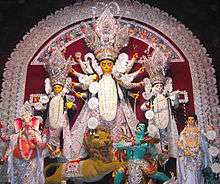
Haralal Mitra Street
This street is one of the most old and famous streets of Bagbazar, where the main Bagbazar Post Office is also located. The annual Saraswati puja of "Haralal Athletic Club " is one of the most famous pujas in Bagbazar. Some of the most popular and vintage buildings here are The No 4 Ghosh residence., a 100 yrs old building still standing strong with its heavy iron pillars and big front entrance. Then there is the very old "Savitri Girls School".
Durgacharan Mukherjee Street
The famous adda of `The Birds`or popularly known as `pakkhir adda` started within the vicinity of Mukherjee family's ancestral premises. The Birds were famous for there long standing association or affinity with Ganja, Charas and Guli. They camoflouged their presence as various types of birds as according to the level of intoxication.
Bosepara
Bosepara, which now forms part of Bagbazar, was set up by the Boses and Pals migrating from Hooghly district. Nidhuram Bose is believed to have arrived before the British came to Sutanuti.The Bagbazar High School is a very old school there.[2]
Nandalal and Pasupoti Bose's house
The house is located on the North side of Bagbazar Street. Late 19th century Bengal found this house as one of the hub for nationalist politics. Many important meetings were held in this house during the course of anti partition politics in 1904-5. The famous procession to raise protest against partition of Bengal led by Rabindranath and other eminent persons started from Federation hall and ended at this house.
Bagbazar Ghat
Bagbazar Ghat, on the Hooghly River is an old one. It was once called Rogo Meeter’s Ghat after Raghu Mitra, son of Gobindram Mitra, the black zemindar, and once one of the wealthiest and most influential natives of Kolkata, in the early days of the British East India Company.[4]
There is steamer jetty next to Baghbazar Ghat, ghat in Bengali is a paved staircase. Steamers carry passengers to the opposite bank of the river, as also the office localities around B.B.D. Bagh, Esplanade and Howrah. The old ghat is used by bathers, people collecting Ganges water for religious ceremonies, for performance of religious ceremonies, and for such mundane tasks as unloading country boats carrying various materials.
Maayer Ghat
Maayer Ghat previously known as Pagla Babur Ghat, is also a place where holy mother Sarada Maa has spent her final days. This is the place where people come to visit Maayer Bari, spend time and see the idols of the holy mother.
Sarada Maa was brought to Calcutta in the home on 27 February 1920. She stayed for next five months until she died at 1.30 am on July 20, 1920. Her body was cremated at the Belur Math.
Battle with Siraj
Bagabzar has also seen battle - on 16 June 1756, a small force under Ensign Piccard repulsed an advance guard of Siraj ud-Daulah from the north, but two days later Kalikata fell in the Battle of Lal Dighi.[5]
Association with Sri Ramakrishna
Possibly the first visit to a house in north Kolkata by Sri Ramakrishna was in 1877. He visited the ancestral house of Kalinath Bose, then numbered 40 Bosepara Lane (presently 47B, Ma Saradamani Sarani). It was here that he first met Harinath Chaterjee (later Swami Turiyananda), Gangadhar Ghatak (Gangopadhyay) (later Swami Akhandananda) and Girish Chandra Ghosh, the noted playwright.[6] The Ramakrishna Sarada Math is housed at 10, Ramakrishna Lane, Baghbazar.
Sister Nivedita came and lived in 53/1 Bosepara Lane. “Bagbazar in the northern part of Calcutta had its own fascination for Sri Ramakrishna’s devotees. On one side stood Balaram Bose’s house, the ‘Calcutta Citadel’ of Sri Ramakrishna, where his disciples repaired for rest. On its north-east is the huge family mansion of Girish Chandra Ghosh. A little to its north was the Holy Mother’s house. All these houses were encircled by the Ramkanto Bose Street and Bosepara Lane, whose very dust was trod upon by Sri Ramakrishna.”[7] She opened her school formally on 13 November 1898 at 16, Bosepara Lane, in the presence of Sarada Ma, Swami Vivekananda, Swami Brahmananda, Swami Saradanandane. Her three-storey house was the tallest in the neighbourhood. The Maharatta Ditch could be seen meeting the Ganges at a distance of less than a kilometer. Kashi Mitra Crematorium and the Shmashaneswar Shiva Temple, was situated to the south of the house.[8] The office of Udbodhan, the magazine founded by Swami Vivekananda, is also located in Bagbazar.
Geography
The old Chitpur Road (renamed Rabindra Sarani) was for many years the life line of Bagbazar. It followed the same track as the old pilgrim path built by Sabarna Roy Choudhury from Halisahar to Barisha.[9] Tram tracks along Rabindra Sarani came to Bagbazar in 1904[10] and are being renewed in 2007. While Rabindra Sarani cuts across Bagabazar from north to south, Bagbazar Street cuts across from Bagbazar Ghat in the west to Bidhan Sarani in the east. Girish Avenue is an extension of Chittaranjan Avenue.[11] When it was built in the 1930s, a portion of the house of Girish Chandra Ghosh was spared and stands in the middle with the two flanges of the road on both sides of the house. There are numerous lanes and by lanes in Bagbazar.
Bagbazar is on the Kolkata Circular Railway. Shyambazar station of Kolkata Metro is within walking distance of most parts of Bagbazar.
Demographics
Ward No. 7 of Kolkata Municipal Corporation[12] under Shyampukur police station, which broadly covers Bagabazar, had a population of 20,012, as per 2001 census. Out of this 10,518 were males and 9,494 were females.[13]
Culture
Alaler Gharer Dulal (The Rich Man’s Spoilt Child) (1857) by Peary Chand Mitra has an interesting piece of women's conversation centred on Bagbazar, possibly when they went for a bath in the Hooghly River:
- "Some are speaking of their oppressive sisters-in-law, some are cursing their tyrannical mothers-in-law, some are tired of life because of the kicks they receive from their daughters-in-law, particularly when their sons are too timid to intervene; some complain of the intolerable behaviour of the wives of their husband’s brothers and some say how keen they are to get their ten-year-old sons married."[14]
Bagbazar has been home to many a creative person.
Nagendranath Basu (1866 – 1938) took twenty years to edit the 22 volume Biswakosh, Bengali encyclopaedia. He lived and worked at 8 Kantapukur Bylane in Bagbazar. Kolkata Municipal Corporation renamed it Biswakosh Lane. This is possibly the only road in the world named after a book.[15]
Mohanchand Basu, who lived in Bagbazar in the 19th century and was a disciple of Nidhu Babu, introduced kheur in Bengali akhrai songs.[16]
Bhola Maira (18th-19th century), the renowned kaviyal (verse-contestant) had a sweet-meat shop on Bagbazar Street.[17]
Two auditoriums, side by side on Bagbazar Street, still testifies to active cultural life of Bagbazar. Girish Mancha, opened in 1986 has over 900 seats. .[18] The auditorium of Paschim Banga Jatra Akademi is next door.
However, the 125 year-old Bagbazar Reading Library is not in good shape because of paucity of funds.[19]
Bagbazar Durga Puja continues to a major crowd puller with its deity of traditional design and innovative decoration.
Transport
- CSTC Buses
- S2B Bagbazar – Kalikapur via Shyambazar, Maniktala, Sealdah, Moulali, CIT Road, Park Circus, Gariahat, Ballygunge Station, Ruby Hospital
- S17A Ariadaha – Kudghat via Baranagar, Kashipur, Bagbazar, Sovabazar, Central Avenue, Esplanade, Rabindra Sadan, Hazra, Rashbehari, Tollygunge
- S21 Bagbazar – Garia Bus Stand via Shyambazar, Khanna, Ultadanga, E.M. Bypass, Science City, Ruby Hospital, Patuli
- Private Bus
- 3 Bagbazar – Serampore Station via Shyambazar, Chiria More, Sinthee More, Dunlop, Dakshineshwar, Ballykhal, Uttarpara, Dharsha, Konnagar, Rishra
- 43 Esplanade – Bonhooghly
- 79B Bagbazar – Barasat Champadali via Shyambazar, Belgachia, Lake Town, Nagerbazar, Airport Gate No.1, Birati, B.T. College, Madhyamgram Chowmatha, Dakbungalow More
- 93 Bagbazar – Kharibari via Shyambazar, Belgachia, Lake Town, Nagerbazar, Airport Gate No.1, Birati, B.T. College, Madhyamgram Chowmatha, Badu
- 240 Bagbazar – Golf Green via Shyambazar, Hatibagan, Bidhan Sarani, College Street, Sealdah, Moulali, CIT Road, Park Circus, Gariahat, Dhakuria, Jadavpur P.S., South City, Lord's More
- 240/1 Bagbazar – Golf Green via Shyambazar, Hatibagan, Bidhan Sarani, College Street, Sealdah, Moulali, Mullickbazar, Minto Park, Lansdowne, Sishumangal Hospital, Deshapriya Park, Gariahat, Dhakuria, Jadavpur P.S., South City, Lord's More
- WBSTC Franchisee Bus
- Bagbazar – Garia Railway Station via Shyambazar, Khanna, Ultadanga, E.M. Bypass, Science City, Ruby Hospital, Patuli, Dhalai Bridge
Gallery
-
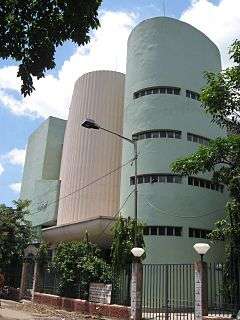
Girish Mancha
-

Auditorium of Paschim Banga Jatra Akademi
-

House where Sister Nivedita started her school in 1898
-

Girish Avenue. At the time of the construction of the road, a portion of the house of Girish Chandra Ghosh was left in the middle.
-
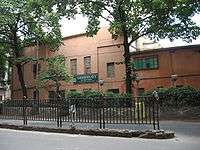
House of Balaram Bose, now Ramakrishna Math
-

Bosepara Lane in Bagbazar
-

The steamer jetty as seen from Bagbazar Ghat
References
| Wikimedia Commons has media related to Bagbazar. |
- ↑ "Shyapukur Police Station". Kolkata Police. Archived from the original on 2007-09-27. Retrieved 2007-08-10.
- 1 2 3 Nair, P. Thankappan in The Growth and Development of Old Calcutta, in Calcutta, the Living City, Vol. I, edited by Sukanta Chaudhuri, p. 17, Oxford University Press, ISBN 978-0-19-563696-3.
- ↑ Cotton, H.E.A., Calcutta Old and New, 1909/1980, p. 34, General Printers and Publishers Pvt. Ltd.
- ↑ Cotton, H.R.A., pp. 281,290
- ↑ Cotton, H.E.A., p290
- ↑ The stone tablet outside the house records this in detail. The visit has been described by Swami Turiyananda and Girish Chandra Ghosh, and quoted by Christopher Isherwood in his Ramakrishna and His Disciples, Advaita Ashram, pp 228-229, 249. However, Christopher Isherwood does not mention any name. These are given in the stone tablet.
- ↑ Pravrajika Atmaprana, Sister-Nivedita of Ramakrishna-Vivekananda, pp. 4-5, Sister Nivedita Girls’ School.
- ↑ "Udbodhan". A brief history of the area around. Ramakrishna Math, 1 Udbodhan Lane, Kolkata - 700003. Archived from the original on 1 August 2007. Retrieved 2007-08-05.
- ↑ Nair, P.Thankappan, Civic and Public Services in Old Calcutta, in Calcutta, the Living City, Vol I, p. 228.
- ↑ Nair, P.Thankappan, Civic and Public Services in Old Calcutta, p.235.
- ↑ Map no. 5, Detail Maps of 141 Wards of Kolkata, D.R.Publication and Sales Concern, 66 College Street, Kolkata – 700073
- ↑ "Municipal Wards". Calcutta. Clcutta Yellow Pages. Archived from the original on 4 August 2007. Retrieved 2007-08-05.
- ↑ "Census of India 2001". Provisional Population Totals, West Bengal, Table 4. Census Commission, Government of India. Archived from the original on 2007-09-27. Retrieved 2007-08-05.
- ↑ Dasgupta, Rabindra Kumar, Old Calcutta as Presented in Literature, in Calcutta, the Living City, Vol. I, p. 130
- ↑ Majumdar, Swapan, Literature and Literary Life in Old Calcutta, in Calcutta, the Living City, Vol. I, p. 111
- ↑ Mitra, Rajyeshwar, Music in Old Calcutta, in Calcutta, the Living City, Vol. I, p. 182
- ↑ Banerjee, Sumanta, The World of Ramjan Ostagar, the Common Man of Old Calcutta, in Calcutta, the Living City, Vol. I, p. 82
- ↑ "Places of Interest In and Around Kolkata". Girish Mancha. West Bengal Government. Retrieved 2007-08-05.
- ↑ Sarkar, Sebanti. "Reading landmark in the doldrums". The Telegraph, 20 June 2007. Retrieved 2007-08-05.
External links
![]() Kolkata/North Kolkata travel guide from Wikivoyage
Kolkata/North Kolkata travel guide from Wikivoyage
Coordinates: 22°36′11″N 88°21′58″E / 22.603°N 88.366°E
